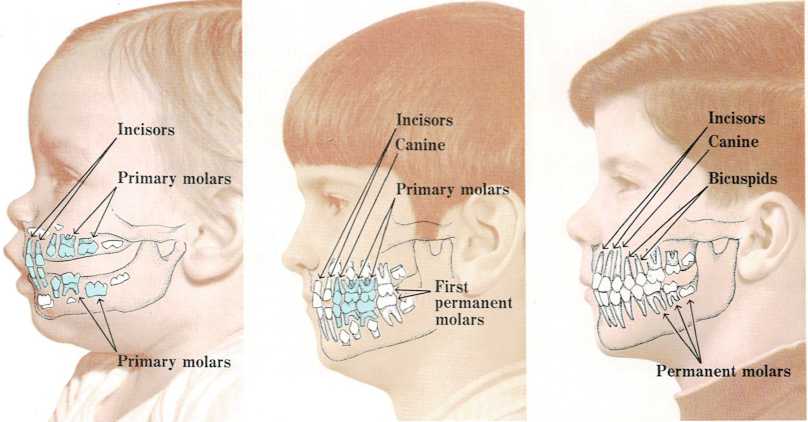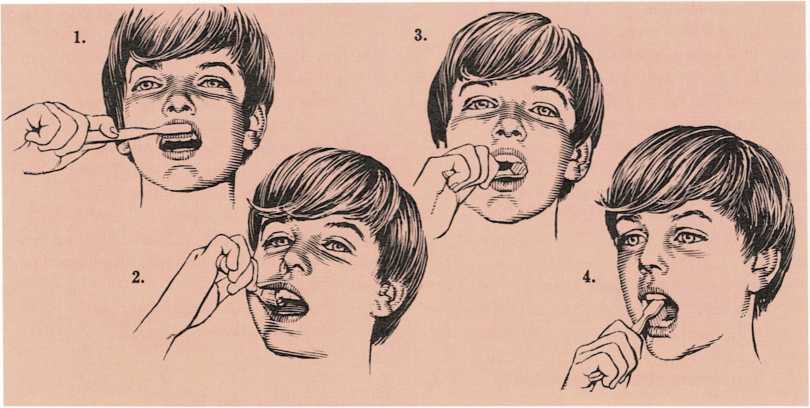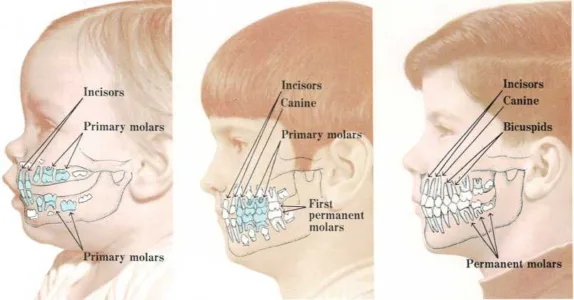Tearing Eyes – Teeth
Tearing eyes. It is not unusual for a baby’s eyes to water during
the first few weeks of life. The doctor puts silver nitrate, or
antibiotic drops or ointment, into the
Tearing eyes \| 301
baby’s eyes at birth to prevent infection. This often causes many tears.
The watering usually disappears in a few days, and no treatment is
necessary.
However, persistent watering may occur if a tear duct becomes blocked by
mucus. The tear duct is a small tube leading from the tear sac (which is
inside the lower eyelid next to the nose) to the inside of the nose.
Normally, the duct carries away the tears that lubricate the eye. But if
the duct becomes blocked, the eye waters.
Treat tearing eyes by wiping away the excess fluid with a small piece of
sterile cotton that has been moistened in cool boiled water. If the
condition continues after the baby is about 2 months old, if it is
severe, or if it is accompanied by irritation and reddening of the eye,
or by a discharge of pus, consult the baby’s doctor, [m.g.]
See also Conjunctivitis
Teeth and teething. The first primary, or “baby,” teeth begin to
form within a baby’s jaws about two months after conception. At
birth, the crowns of all 20 primary teeth, and even part of the first
permanent molars, are forming in the jaws. By the time a child is 3
years old, all the primary teeth have come in. By this time, too, parts
of more than 20 of the permanent teeth are developing within the
jawbones.
Your baby will probably get a first tooth at about 6 months. Generally,
the teeth in the lower jaw appear first. At 1 year, your child will
probably have the four upper and four lower front teeth, which are
called the incisors.
The first molars appear when the child is about 15 months old. Then, at
about 18 months, the canines come through between the incisors and the
first molars. The second molars, or “back teeth,” usually appear when
the child is about 2 years old.
Teething. As a tooth comes through, your baby will drool, bite, chew,
and gnaw on anything that can go into the mouth. The baby may also
thrust the lower jaw forward and move it from side to side to rub the
gums together and help the teeth push through the overlying tissue. Firm
teething
Teething

When a child is about a year old (left), primary incisors have
pushed through the gums and primary molars are beginning to appear. By
about 8 (center), a child has some permanent teeth—incisors and first
permanent molars—and some primary teeth — canines and primary
molars. At about 12 (right), a child has all the permanent teeth
except for the third permanent molars (wisdom teeth).
How to brush teeth

1. The hand should be twisted so that the brush moves over the gums
and teeth toward the chewing surfaces. The upper teeth should be
brushed downward; the lower teeth upward.
2. Be sure the surfaces next to the cheeks are brushed.
3. And be sure the surfaces next to the tongue are brushed.
4. Teach your child to use a scrubbing motion when brushing so that
the chewing surfaces of the teeth are cleaned.
rings may satisfy the urge to bite. Chewing hard foods like toasted
bread may help teething and jaw development. Babies may be fussy while
teething, and this irritability may be confused with signs of illness.
Usually, a child has more difficulty getting the primary teeth than
getting the permanent teeth. The primary teeth have to make their
own-path through the gums, but 20 of the permanent teeth follow the
paths already made by the primary teeth they replace. The 12 molars in
the set of 32 permanent teeth have no channel set up for them by
preceding primary teeth. Fortunately, they do not come in until the
child is older. The first permanent molars usually appear when the child
is about 6 years old, the second molars when the child is about 12, and
the third molars (wisdom teeth) after the child is 17 years old.
Dental care. Foods that are good for general health—milk, fruits,
vegetables, meat, poultry, fish, eggs, and butter—are also good for
teeth and gums. Fibrous vegetables and fruits that require chewing have
the added value of acting as tooth-cleansing
agents. Some foods can harm teeth. Sugars and starches actually
encourage tooth decay.
Tooth decay usually begins in the pits and grooves on the chewing
surfaces of the teeth, between the teeth, and along the gum margin on
the cheek sides. Bacteria act upon food particles, producing acids and
other substances that can dissolve tooth enamel and eat away the
underlying dentine. Sugars are the most harmful foods because they more
readily produce acids.
Many children eat far more sugar than they need for good nutrition. To
reduce tooth decay, substitute fruit, nuts, popcorn, cheese, and other
sugarless snacks for sweets. Try to satisfy your child’s appetite for
sugar by supplying sweets at one meal a day.
Teach your child to use the toothbrush at about 2 years. To encourage
your child, let him or her pick out a toothbrush. Supply an attractive
tumbler for rinsing the mouth, a small size of toothpaste or powder, and
a sturdy stool to stand on so that your child can reach the washbasin.
For best results, encourage brushing after every meal.
Regular dental examinations are the surest way for your child to have
healthy teeth and to keep the teeth for a lifetime. Your child’s first
visit to the dentist should be made at 3 years, soon after all the
primary teeth are in. Before the first visit, take the child with you on
one of your routine visits to your dentist. Arrange this beforehand with
your dentist so that your child may sit in the dental chair, examine
some of the instruments, and get acquainted with both the dentist and
the surroundings. Then the first real visit will not be strange and
alarming.
If your child has a tooth knocked out, save the tooth and call your
dentist immediately. It may be possible to reinsert and retain the
tooth. [m.g.]
See also Braces, dental; Malocclusion

